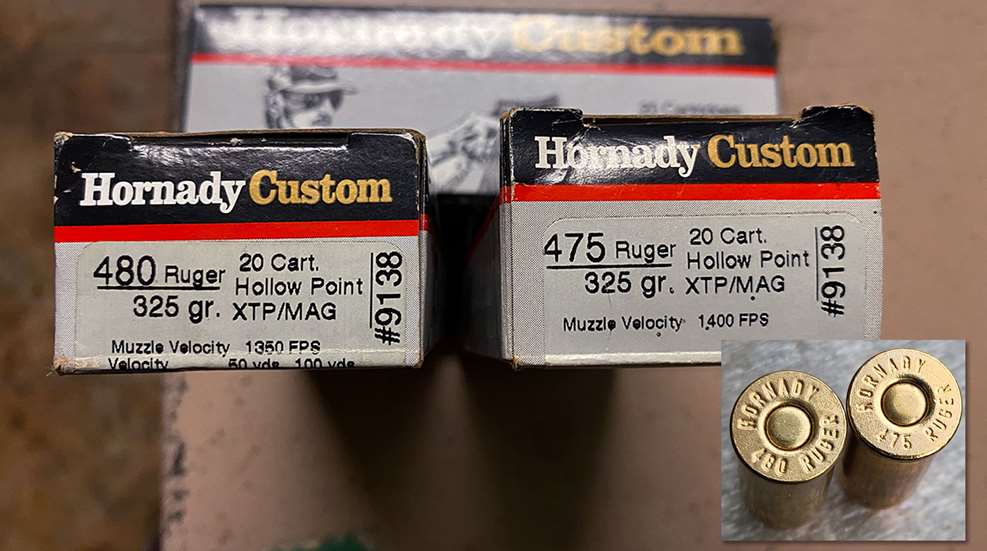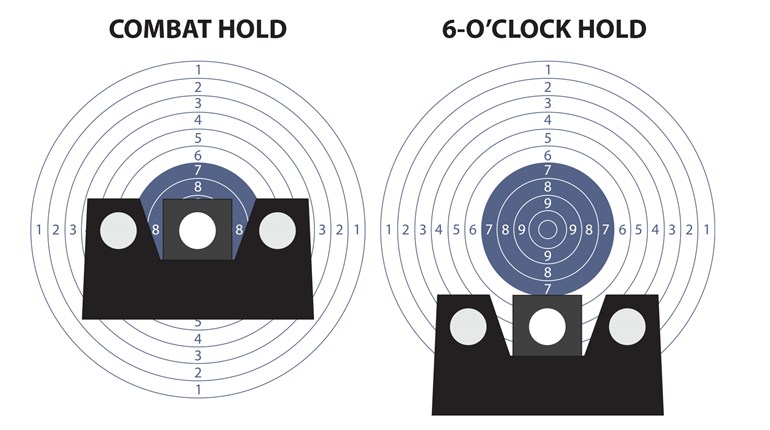
My love for big-bore revolvers has been continuous since I bought a Colt Single Action Army chambered in .45 Colt more than 30 years ago as a young lad. For me, the bigger the bullet, the more I liked it. I have more than one example of big-bore revolvers .45 caliber and larger in my collection. My favorite and current “Truck Gun” for general shooting on the ranch is a five-shot, limited-edition Ruger Super Blackhawk chambered in .480 Ruger. This gun fits my hand perfectly and its felt recoil is less than my Super Blackhawk in .44 Mag., even though it is rated with factory specs as having similar or greater levels of power, depending on the load used.
Recently, I bought multiple boxes of miscellaneous revolver ammunition from a gun shop that was closing its doors. The main attraction was several boxes of Hornady 325-grain .480 Ruger ammunition. When I got home and was sorting through my loot, I discovered a Hornady box marked .475 Ruger. It contained cartridges with “Hornady .475 Ruger” headstamps. The ammunition marked .475 Ruger and the cartridges marked .480 Ruger appeared identical, but the label on the box rated the .475 Ruger ammunition 50 fps faster than the .480 Ruger. Is it safe to shoot the .475 ammo in my .480, or is there another gun out there that I need to track down that is chambered specifically for the .475 Ruger cartridge? I would also be interested in learning why Ruger would introduce two cartridges so similar, but incompatible (if so). There has got to be some history in there somewhere.
Roy L., via e-mail
Your questions created a lot of puzzled looks when I shared it with some of my industry colleagues. I had to do some serious digging to come up with some factual information to answer them.
I am familiar with that cartridge, having shot it and trained others in handgun-hunting classes with it, but had only known it as the .480 Ruger—even though it fires a .475-inch-diameter bullet.
The .480 Ruger revolver cartridge was introduced in Ruger’s Super Redhawk as a handgun-hunting cartridge midway in power between the .44 Mag. and the .454 Casull. It seems that the thinking at the time was to produce a cartridge/gun combination that maximized power and minimized recoil, comparatively speaking, so the average handgun hunter could handle it. The .475 Linebaugh cartridge was a consideration, but the recoil was similar to, if not worse than, the .454 Casull. In the resulting calculations, the ballistic figures for a .475-diameter bullet that fulfilled the goal that had been set was a 325-grain bullet traveling at 1,350 to 1,400 fps. This was less than the .475 Linebaugh to the degree that it allowed the .475 Linebaugh case to be shortened by .1 inch and still meet the ballistic goal at a lower-pressure rating.
Ruger and Hornady had and still have a close working relationship, so together they went to work creating the first handgun cartridge with the Ruger name attached to it. The first prototype pre-productions cartridge cases were headstamped .475 Ruger for use in the developmental stages of creating a new revolver cartridge. It is a logical assumption in an effort to avoid confusion as well as to differentiate the .475 Ruger offering from the .475 Linebaugh, the name was changed to .480 Ruger. The cartridge cases you have that are marked .475 Ruger were most likely cases that were unused in preproduction testing and repurposed in an early production cycle rather than being relegated to the scrap pile. Another possibility is the ammunition could have left the factory as test samples that failed to be returned after the tests were completed. These examples are speculative on my part, but they provide a reasonable explanation as to how the ammunition left the factory marked as such.
The 1,400 fps rating on the .475 Ruger ammunition versus the 1,350 fps rating for the .480 Ruger ammunition is likely insignificant in that either velocity is only considered moderate with a 325-grain bullet. Other manufacturers have since loaded the .480 Ruger cartridge to higher levels of performance, but that is at the expense of the original idea of producing an acceptable amount of recoil in a hunting revolver.
The .480 Ruger is a great cartridge for those who understand and use it for what it was intended. Unfortunately, the timing of its introduction could have been planned better, with other more powerful cartridges simultaneously being introduced by competitors. Also, considering the American consumer mindset (if some is good, more must be better), a magnum-class cartridge without the “magnum” attached to its name—particularly when said cartridge does not have the punishing recoil of its peers—will be less appealing to the average consumer than one that does have the magnum moniker.




































